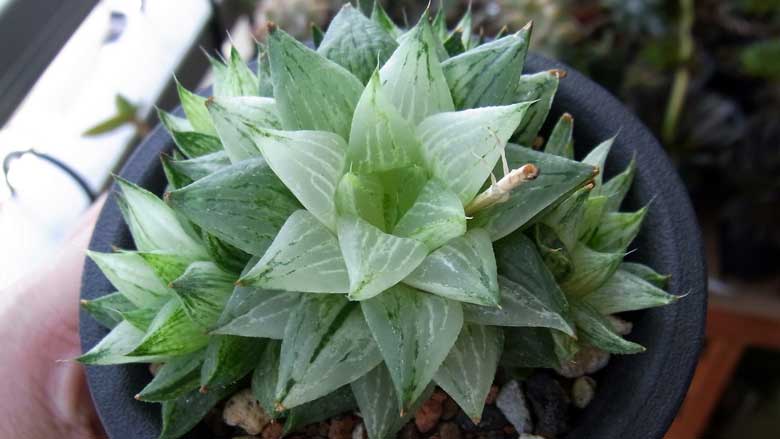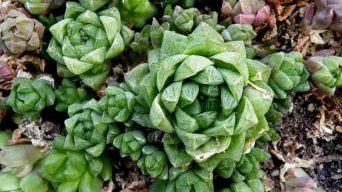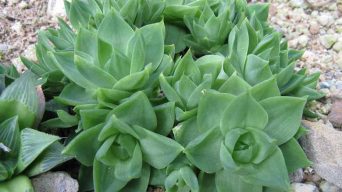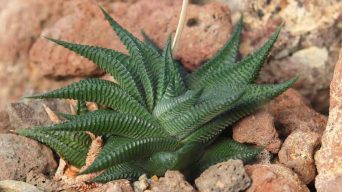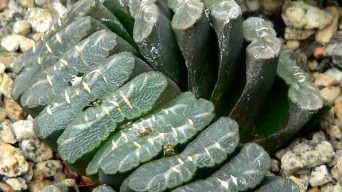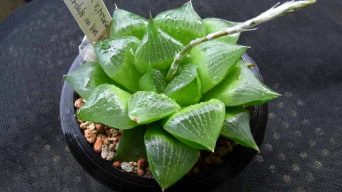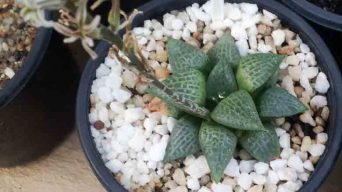The Haworthia turgida is a succulent plant that belongs to the Haworthia genus.
This plant has been used as an ornamental houseplant for many years, and its popularity continues to grow. The Haworthia turgida is low-maintenance and grows well indoors in areas with decent light.
In this blog post, we will discuss how you can care for your Haworthia turgida and propagate it so that you can have more plants around your home!
Overview
The Haworthia turgida plant is a species of the genus Haworthia and Asphodelaceae family native to the Cape Provinces of South Africa.
Haworthia turgida succulents form bright, green rosettes that grow up to 4 inches (10 cm) and form dense clusters quickly.
This small succulent plant has translucent leaves that show green veins, becoming reddish when exposed to intense sunlight.
One of the key features of this succulent plant is that mature rosettes grow single, upright stems with small white flowers.
How To Care for Haworthia Turgida
Haworthia turgida care is simple and easy to do.
The most important considerations to make when caring for this Haworthia species are outlined below.
Sun Exposure & Light Requirements
Haworthia turgida succulents require full to partial sun but can also be grown indoors.
The Haworthia plant will need at least six hours of sunlight per day outdoors.
Haworthia turgida are sun-loving plants, and when grown indoors, they require a bright window with plenty of sunlight.
For the best growth for all Haworthia species, it’s important to provide them with an east-facing windowsill or near a south-facing window where they will receive indirect sunlight during the winter months (when there is little direct sun).
Watering Requirements
Haworthia turgida is a drought-tolerant succulent plant that must not be watered daily.
However, the soil should be moistened thoroughly at least once weekly for the Haworthia plant to thrive.
But, as a general rule, the soil should be allowed to dry out completely between watering.
Soil Requirements
The Haworthia turgida requires excellent drainage with a fast-draining potting mixture and prefers to be planted in soil that is on the dry side.
The best type of soil for the Haworthia turgida is a soil mixture of equal parts loam, peat moss, and coarse sand.
When potting Haworthias, using only a fast-draining cactus/succulent potting mixture is important so that water can flow through easily without sitting too long in the pots.
Temperature and Humidity
The Haworthia turgida thrives in temperatures between 60° F (16° C) – 100° F (38° C).
They will do best when placed outdoors during warm seasons of the year on shady patios and covered decks with plenty of hours for daily direct sunlight exposure.
During cooler weather periods, the Haworthia turgida will do well indoors and can be placed in a sunny window.
All Haworthias are sensitive to cold temperatures and should not be exposed for extended periods below 40° F (40° C).
Haworthia turgida needs low humidity when growing in the home.
However, it thrives outdoors with high relative humidity levels during warm weather months because its natural habitat is a desert region in Africa.
Fertilizing
Haworthia turgida plants don’t require much fertilizer. Still, you can fertilize them once or twice a year with cactus fertilizer to keep the plants healthy and grow well.
A fertilizer for cactus diluted to half strength can be used to fertilize your Haworthia.
Once or twice a year, water the Haworthia plant with a fertilizer solution of one tablespoon to four liters of water.
If you fertilize too heavily, the Haworthia will start to grow in an unproductive way and produce more succulent leaves than flowers or babies (cuttings).
Potting and Repotting
Potting and repotting haworthia plants is not difficult.
One should only be mindful of the size that will work best for one’s plant and the type of soil to use.
When moving succulents to a new location, water your Haworthia turgida plant well in advance to avoid getting too stressed during its move from one container to another.
This can help prevent root rot and other damage when moving them around.
The first thing you need to do is choose a container with drainage holes. This will help Haworthia turgida plants stay healthy by allowing the soil to retain just enough water to not get too wet or dry out.
Next, one should use a lightweight potting mix for Haworthia turgida plants since this type of plant needs porous soils to thrive well.
The best types of soil are cactus potting mix or succulent potting mix.
This type of succulent only needs to be repotted about every two years. Still, Haworthia turgida plants in pots or containers with poor drainage might need to be repotted more often.
Pruning
Haworthia turgida plants don’t need to be pruned. Still, it’s a good idea to do an occasional pruning if you want the plant to grow.
- Cut off any broken, dead, or diseased leaves using sharp scissors.
- Pinch back haworthia turgida plants that may be growing taller than desired and are beginning to suffocate other plants in your collection.
- Cut haworthia turgida plants back to the ground if they grow too tall and begin to produce fewer leaves.
Pests and Diseases
The Haworthia turgida plant is a succulent that has few pests or diseases.
These Haworthia succulents are resistant to pests such as spider mites.
The only pests that they may be threatened by are mealybugs. Still, these are easily removed with a cotton swab dipped in rubbing alcohol.
The Haworthia turgida plant may be susceptible to fungal infections, which can cause yellow patches on the leaves, twig dieback, and stunting of new growth.
The best way to avoid this is by planting it outdoors or using a potting mix that contains fungicides such as thiophanate methyl and copper sulfate pentahydrate.
It is important not to overwater these plants because they have sensitive root systems that will rot if waterlogged for too long.
Only water them when the top inch of soil feels dry- give them one good watering per week at most!
This Haworthia succulent doesn’t need to be watered more than once a week.
How to Care for Haworthia Turgida in Winter
Haworthia turgida prefers to be kept cool and dry during this time of year as it has no cold or drought tolerance.
- DO NOT overwater the plant.
- DO provide a well-drained soil mix or cactus mix with plenty of pebbles, perlite, and pumice. You can even add some charcoal to increase water filtration.
- Haworthia turgida should be kept in bright light indoors, but do not over-expose it to direct sun, making its leaves go limp. If you must move it outdoors for a short time, ensure that there is always partial shade coverage.
- Protect Haworthia turgida from frost by moving them inside or placing them under shrubs/plants or next to walls if they are being grown outside.
- Haworthias should be watered sparingly and only when the top of the soil feels dry to the touch (not bone dry). You may water less often during winter than at other times of the year as it does not need a lot of water due to its succulent nature.
How To Propagate Haworthia Turgida
The Haworthia turgida is easily propagated by offsets or cuttings.
Offsets
The Haworthia turgida offsets can be detached from the mother plant with a knife or clippers.
Care should be taken not to damage the root ball when detaching an offset.
These offsets are known as “pups” and will grow into mature plants in about one growing season (about two years).
You’ll want to place these pups around, below, or above their parent so that it is shaded during hot days and gets some sun during cooler times of the day. This will help them form roots more quickly since Haworthias love the shade but also need sunlight for proper growth.
Once enough new shoots are on the pup, they can be transplanted elsewhere if desired; otherwise, you can leave them as they are.
Cuttings
The other way to propagate Haworthia turgida is by cuttings. There are two ways to do so: from leaves (leaf propagation) or stems (stem cutting).
The leaf propagation method is straightforward: you can remove a healthy, mature leaf from the plant.
Once removed, allow it to callous for several days and place this new leaf cutting in the soil to start rooting immediately.
To propagate by stem cutting, all one needs to do is take a cutting from the stem with a clean, sharp blade.
Allow this to callous for about one week, then plant it in soil for rooting.
Is the Haworthia Turgida Toxic?
Haworthia turgida plants are not toxic to humans or pets.
The haworthia plant has an acidic sap, meaning there is a low risk of skin irritation when handling the leaves and stems.
For those who have sensitive skin or suffer from contact dermatitis, it may be prudent to wear gloves if there’s any doubt about whether the Haworthia will irritate your hands.
The acidity in this type of haworthia does not typically cause problems for most people. Still, some allergies do exist, so watch out!
Final Thoughts
The Haworthia turgida is a relatively easy succulent plant to care for.
As long as it receives the right amount of sunlight and water, Haworthia turgida will do well in any home or office environment.
Propagating Haworthia turgida is also pretty easy if you know how to take care.
This makes the Haworthia turgida plant an excellent choice for a novice succulent owner.

